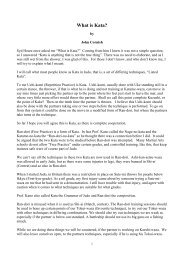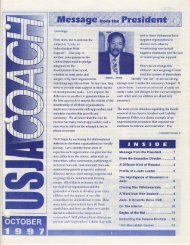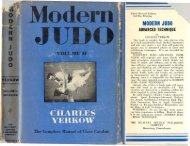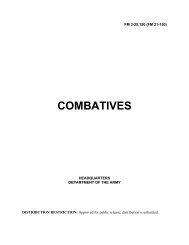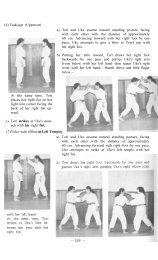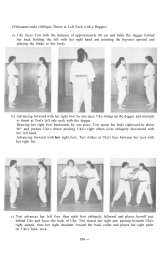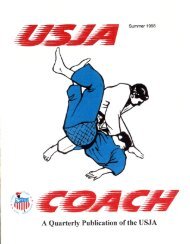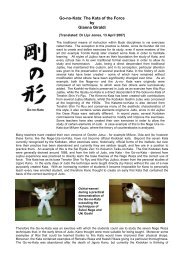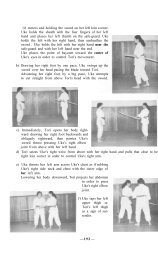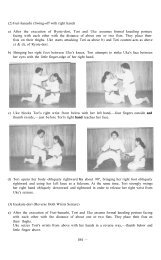Fall 1998 - Judo Information Site
Fall 1998 - Judo Information Site
Fall 1998 - Judo Information Site
You also want an ePaper? Increase the reach of your titles
YUMPU automatically turns print PDFs into web optimized ePapers that Google loves.
USJACOACH<br />
'fu-<br />
a a a a a a a a a a a<br />
STRENGTH TRAINING FOR THE JUDO COMPETITOR<br />
by Terry J. Kelly, Rokudan/<strong>Judo</strong>; Rokudan/Jujitsu Head Coach, Santa Rosa Junior College<br />
<strong>Judo</strong> and Sonoma Coast <strong>Judo</strong>; Califomia Co-Chairman, USJA Cedification Committee<br />
Strength is one ofthe tactical variables<br />
in any combative sport. In <strong>Judo</strong>, this<br />
variable can mean the difference between<br />
winning or losing a match. And this could<br />
be the match that determines if your player<br />
takes home a medal. Strength provides the<br />
mechanism to deliver the technique, and<br />
muscle strength must be accompanied by<br />
muscle endurance.<br />
In this article, I will provide a brief<br />
introduction to the terms and principles of<br />
muscle strength training, and their<br />
application to modern <strong>Judo</strong> competitive<br />
techniques.<br />
First, the Coach must be familiar with<br />
the very basics of kinesiology - the study<br />
of muscle movement. In my travels<br />
throughout the country, many times I have<br />
seen athletes spending time and effort on<br />
exercises having no transference to the<br />
sport of <strong>Judo</strong>. The majority of these<br />
exercisepractices have been inherited from<br />
the Coach's own past experience. But,<br />
because it has always been done, does not<br />
mean it is effective, or cannot be changed.<br />
For example, why do <strong>Judo</strong> players warm<br />
up with the old jumping jacks exercise?<br />
This movement has no direct transference<br />
to actual effective <strong>Judo</strong>, yet in many clubs,<br />
it is a common warm-up activity. I<br />
remember doing countless jumping jacks<br />
in the Army - but I don't ever remember<br />
the exercise having anything to do with my<br />
actual military activities. Training time for<br />
our athletes should not be wasted on<br />
meaningless activity.<br />
So, back to kinesiology. Muscles work<br />
in three ways. A: Concentric, or towards<br />
the center; B: Eccentric, or away from the<br />
centen and C: Static or isometric. in a fixed<br />
position. The vast majority of <strong>Judo</strong> skills<br />
involve one or more of these principles.<br />
So what does this mean to a Coach?<br />
Let's see if I can iltustrate how this type of<br />
knowledge can be used to improve a <strong>Judo</strong><br />
competitor's application of terminal<br />
competitive technique.<br />
First, examine what the technique is<br />
supposed to do. Is it a lifter, a roller or a<br />
driver? Where does the power movement<br />
come from? What is the driving leg doing?<br />
Where is the power hand, and the locking<br />
hand?Are you working for a specific angle<br />
of attack? Then, examine the muscle<br />
movement. Is it concentric, i.e., actively<br />
shortening to produce movement? Or is it<br />
eccentric, actively lengthening to produce<br />
movement? Or, as in some cases, is there a<br />
period of static or isometric muscle<br />
exercise? Once this has been determined,<br />
you can develop a plan with your athlete to<br />
build strength and endurance in the muscle<br />
groups called upon to do the work, and<br />
make the technique effective under a<br />
variety of situations.<br />
As an example, I will share a recent<br />
succes story with you. My daughter, Amy<br />
Kate, decided to resume her competitive<br />
career after a five-year hiatus. Although she<br />
never stopped practicing <strong>Judo</strong>, she had<br />
completely disassociated herself from<br />
competitive applications of her <strong>Judo</strong> skills.<br />
Lots had changed in five years: she needed<br />
a new integrated attack system, and at 66<br />
kilos, she needed muscular strength and<br />
endurance. Just building muscle mass<br />
would not have done the job and would<br />
actually have slowed her down. And as you<br />
all know, speed and movement are two<br />
more very important tactical variables,<br />
which we cannot sacrifice forstrength. This<br />
was going to be a challenge to my coaching<br />
ability and my diagnostic skills, especially<br />
when it came to what type of <strong>Judo</strong> skills to<br />
train for, and what type of weight training<br />
to use.<br />
My first step was to keep detailed notes<br />
from a variety of <strong>Judo</strong> tournaments. I paid<br />
close attention to what was being used,<br />
what worked, and what didn't work, and<br />
the endurance of the players involved. I<br />
reviewed notes from my own travels and<br />
<strong>Judo</strong> training, and looked for the best<br />
possible strength and fitness trainer I could<br />
find - someone with international<br />
experience in both body building and<br />
muscle fitness training.<br />
The first rule of effective coaching -<br />
know your own limitations, and find an<br />
expert to address those limitations. In<br />
Amy's case, she had already made her<br />
choice: Jack Piotorowski is the most<br />
formidable trainer at her gym, Santa Rosa<br />
24-Hour Fitness, and he was not cheap or<br />
easily impressed. After several weeks of<br />
work, Amy, Jack and I did an analysis of<br />
those techniques I felt would suit her body<br />
and her background in progressive <strong>Judo</strong>.<br />
She then embarked on a rigid training<br />
program with Jack, based upon the muscle<br />
demands of the type of <strong>Judo</strong> I wanted her<br />
to do - both standing and groundwork,<br />
quick, explosive, and terminal, with the<br />
endurance for a protracted effort if she<br />
needed it. Not an easy program. Because<br />
of my understanding of the basics of<br />
kinesiology, I was able to break down the<br />
muscle movement of each of her primary<br />
attacks and counter attacks. I was then able<br />
to communicate this to Jack, who prepared<br />
(continued on page 9)<br />
I<br />
:,:, : : :. :];;i;,<br />
1, ;,,<br />
j,<br />
, ,,: : : I : :!<br />
i ! i !: ,:<br />
i i<br />
,,.,,,i,'i:.i:.,,,i,i,,,'i,,i .,r:,<br />
,.,;t11,..l l ',';,,,,,,i,,,,,,.i,':,,,, ..1.1'.'t,,, , ."ii.,i'i:,i:i t:.,,i



